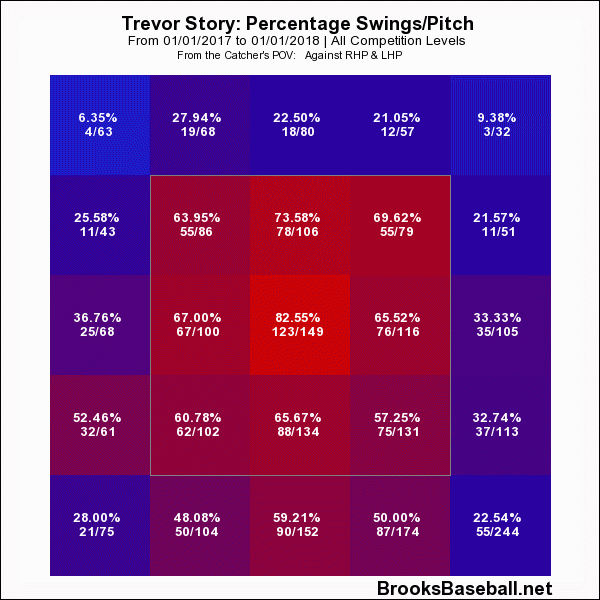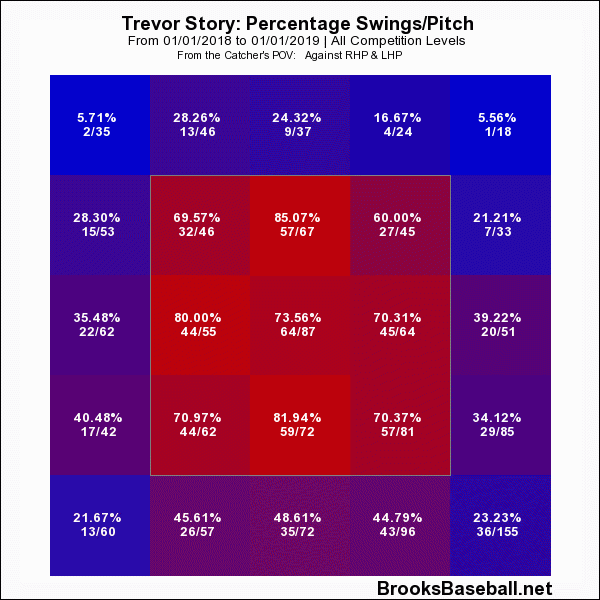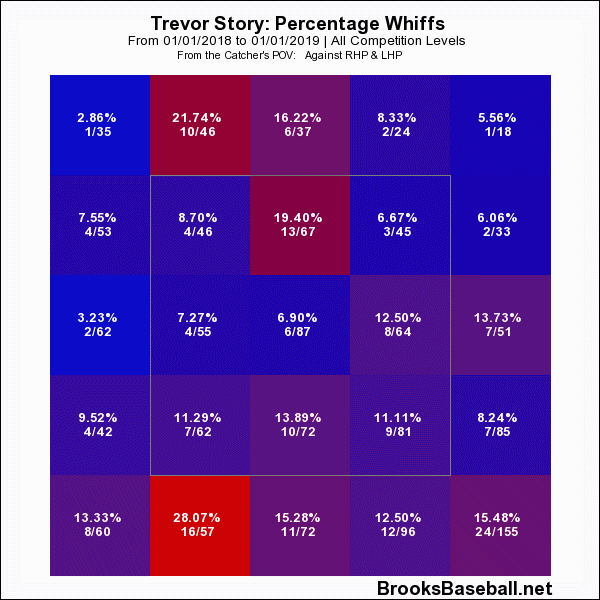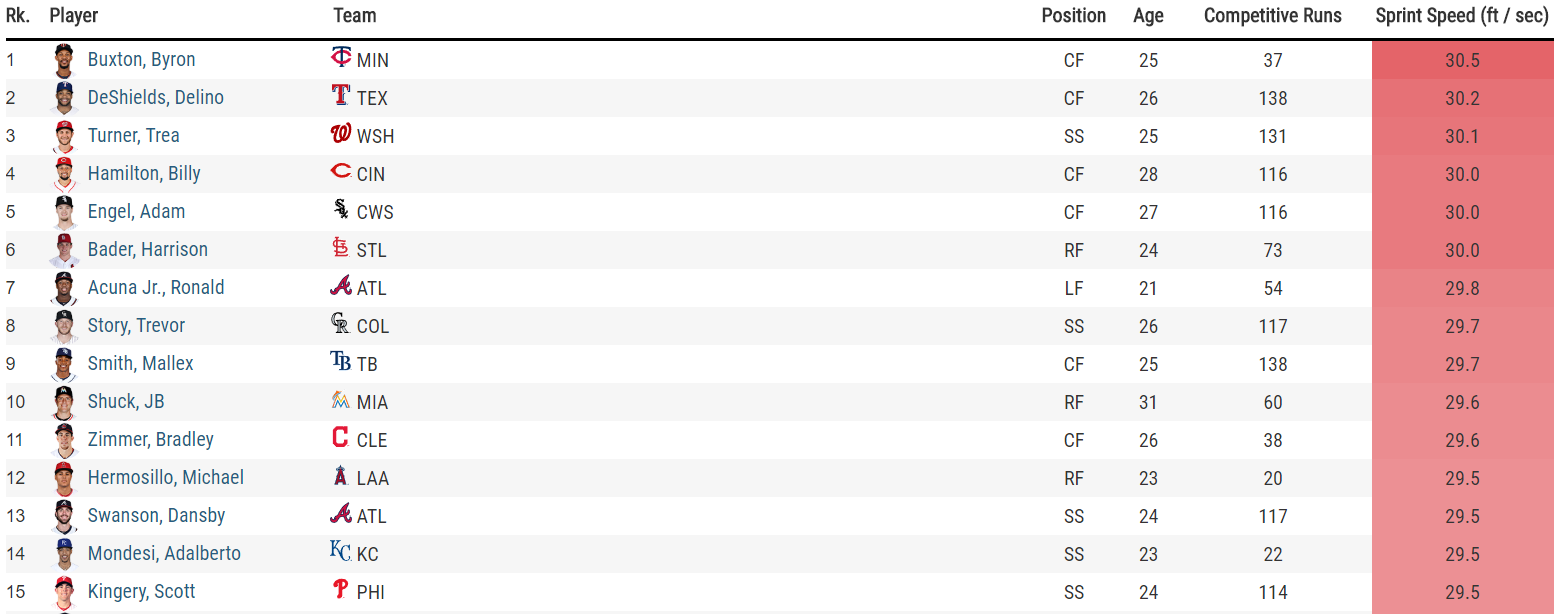© 2025 ALLCITY Network Inc.
All rights reserved.

It’s a simple, if not overplayed, Hollywood trope.
It may be a couple years overdue, but Trevor Story is an All-Star.
A story of promise, then adversity and, finally, vindication. For Story, his plotline went from rookie sensation and snubbing to sophomore bust and now he is on his way to Washington, D.C. as one of three Rockies representing the game’s best.
In 2016, Story was a notable exemption from the All-Star Game, falling in the Final Vote balloting despite his record-setting rookie campaign, OPS’ing above .900. Then a torn ligament in his thumb on July 30 ended his season altogether. When he returned the next year, he wasn’t the same player. His OBP dropped to nearly .300 and he led baseball with 191 strikeouts.
Now, his batting average is just 20 points short of that OBP mark from last season, and his hard-hit rate is more than 7 percent higher than the rest of the MLB. So, what facilitated this change and made Story a player recognizable among his peers as one of the best in the league.
The Discipline Adjustment
The biggest change for Story thus far has been a reduced strikeout rate. While he’s still walking back to the bench every 3.99 plate appearances, well below the MLB rate of 4.47 PA’s per K, it’s more than a full point higher than his 2.91 mark from 2017.
As the adage goes, put the ball in play and good things will happen.
But for Story, the issue was a massive hole in his swing on the low and away part of the plate, particularly chasing pitches offspeed out of the zone:

While Story punished pitches that found the strike zone, hitting those pitches to the tune of a meteoric .474 average, the ground ball percentage on those he put in play were 52 percent, suggesting some luck finding the hole in between first and second or down the line, or pulling them.
But it came down to being too aggressive on those pitches, chasing any pitch below the zone more than half of the time:

Not only would he swing, but often he’d miss, as breaking pitches low and away are the hardest to put a bat upon:
But this year, he’s tightened up his approach to an extent:

Notice how all of his swing percentages outside the strike zone have dropped except for off the outside edge. None are huge decreases and are still elevated from other MLB players, but the difference is he’s now putting the bat on those more, and the rest of the zone overall:

It comes with time
My conclusion is that Story is simply becoming better at pitch recognition and knowing what to do with each one. As he closes in on his 1,500th MLB plate appearance perhaps this season, it’s natural to become more comfortable and see what exactly is coming out of the pitcher’s hand.
This can be seen in his batted-ball profile to right field, in which his hard-hit rate has jumped 6 percent from 2017, resulting a batting average leap from .289 to an astounding .412. His hard contact rate up the middle and the other way is 46 percent, 14 higher than the rest of the league. He’s learning to take what the pitcher is giving him and hit it hard.
Look at this away corner pitch from Jon Lester. It is a fastball, granted, but Story knows that he still needs to wait a little longer and get the barrel behind the ball, instead of pull it:
Aside from driving it up the middle, which is impressive enough, Story gets that pitch in a tough location to travel 380 feet with an exit velocity above 100 mph. It’s just an impressive piece of hitting that we didn’t see from him in previous years.
Here’s another example, in which the pitch is very much down the heart of the plate, but Story recognizes early that it’s going to be a slider:
Seeing that it’s going to break away from him, even down the heart that he could easily extend upon, he anticipates the break and is able to sit back and drive the ball to the wall the other way.
But this is where pitch recognition comes in. It would be one thing if Story was taking a DJ LeMahieu approach and setting up to drive the ball the other way, but that’s not the case. Here’s his complete batted ball profile from each season, from FanGraphs.com:

Story, despite having success going the other way, is actually doing so *less* than he ever has before. When he pulls the ball, he’s hitting .440, with 11 of his 16 home runs this season going to left field, with a hard-hit rate of 44 percent. Simply, his ability to turn on the ball is too valuable to abandon, letting him do things like this:
The pull power has always been there, but he’s becoming comfortable enough to still be able to extend the bat head out in front when necessary to turn on it, in addition to optimizing contact deeper into the strike zone when the ball isn’t in his wheelhouse over the middle or inside.
Knowing his role
Often placed as the No. 4 hitter in the lineup, Story is getting his fair share of at-bats with runners on, with pitchers not wanting to give Nolan Arenado anything to hit in front of him. Story has taken strongly to this role in 2018, improving his batting average of .245 with runners on in 2017 to .318 this year. Additionally, he elevates his PA’s per K to an above-average 4.56, meaning he changes his “swing hard in case you hit it” approach to one with intent to put the ball in play.
Here’s another pitch over the middle of the plate, with velocity and break that he’s pulled before. But, with runners on the corners, he takes a different approach:
Story, rather than using his typical long swing that generates his typical power, just gets the bat into the zone as soon as possible, shooting the ball into right. Shortening up hasn’t really been in his arsenal for the majority of his career, and has enabled him to rack up his RBI total to 62, one behind Arenado for the team lead and six behind Cincinnati’s Eugenio Suarez for the NL lead.
The rest
We would be remiss if we didn’t note how Story has not just improved his offensive game but has become a complete, five-tool player. Let’s start with perhaps his most underrated tool, his speed:

Story is a top-10 runner in baseball and No. 2 among infielders. His natural speed helps him on the bases and extending his defensive range.
But look at the company he is with. Aside from Turner, no other player in the top 10 has double-digit home runs. He is also tied with Turner for tops in batting average and is tied for fifth in strikeout percentage. A case could be made that Story is alone in baseball as a power-speed combination. To find a player with more home runs than Story, you need to go all the way down to No. 35 on the sprint speed leaderboard, to some guy named Mike Trout.
It earns him base hits like it does in this clip on a fairly routine ground ball:
But his speed is also a key contributor in his other underrated tool: his defense. This clip exhibits both his range and his arm strength, reminiscent of a certain former Rockies shortstop:
The range, the leap and the arm strength are all excellent, enticing Drew Goodman to say, “He’s going to win a Gold Glove… or three or four.” He might not be wrong. Story has truly developed into an asset in every facet of the game.
Conclusion
A wiser, more disciplined Trevor Story has earned the Rockies’ shortstop his first All-Star Game nod. Story is avoiding strikeouts more than in the past, but is still fairly prone to the K. However, he’s learned to recognize pitches early and adjust his swing accordingly, going the other way with authority while still being able to extend on inside pitches for the most damage possible. He’s also learned to shorten up for contact when the situation dictates it.
After a disappointing sophomore campaign, Story has grown as a hitter and has developed his defense to an elite level as well. Paired with a top-tier sprint speed, Story has very quietly joined an elite group in baseball that is roughly limited to Mike Trout and Trea Turner, with Ronald Acuna Jr. on the cusp. Now that he’s moved his batting average above .280, it can be argued that Story is a premier player in MLB, producing in every facet at a premium defensive position.
Story’s redemption comes as the Rockies fight for a playoff berth, giving them a unique bat in the heart of the order and some necessary protection for fellow All-Stars Charlie Blackmon and Arenado.
It’s a shame that the MLB doesn’t have a complete skills competition like the NHL, because Story could likely compete in every event.
Comments
Share your thoughts
Join the conversation



